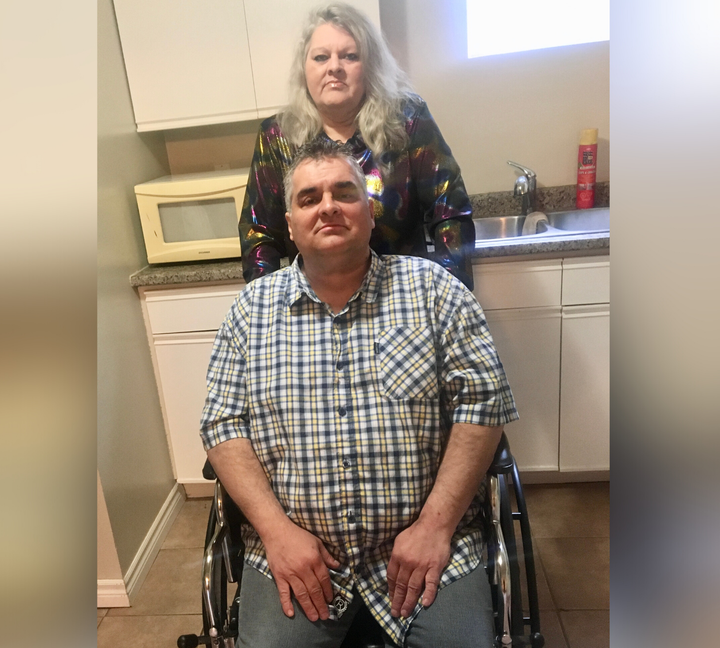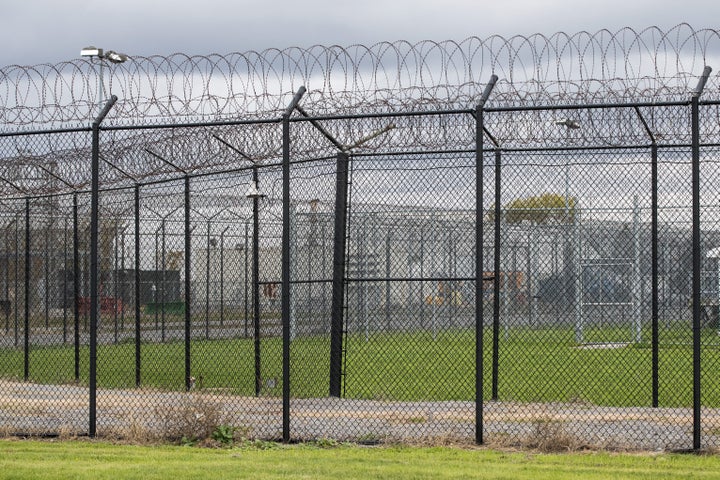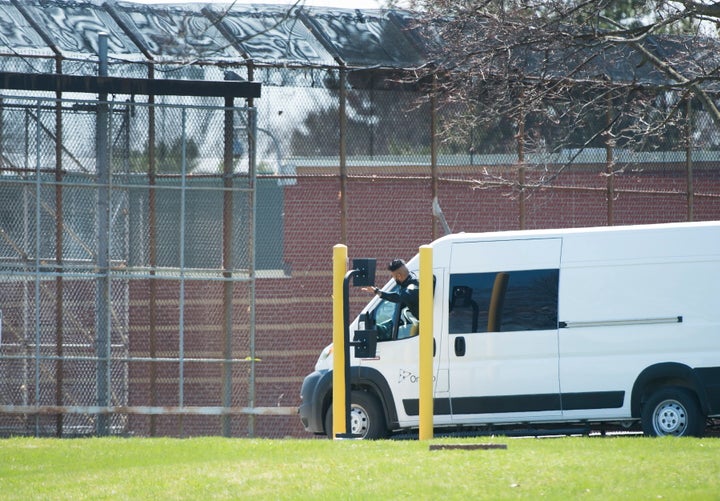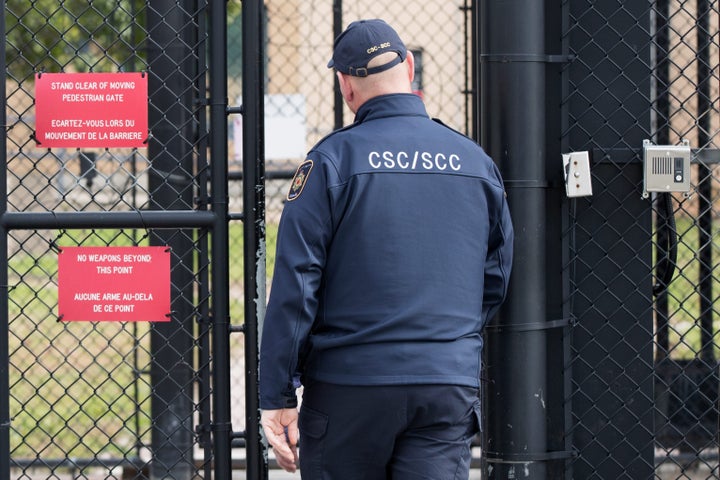
On the TV in the prison’s common area, Derrick Snow watched as the outside world shut down to contain the spread of the highly contagious novel coronavirus.
It was mid-March, and Snow, 53, was recently diagnosed with cancer. He also suffers from lung disease and diabetes. He knew if he contracted COVID-19 he’d likely develop the worst of the symptoms, which include difficulty breathing and pneumonia — and die.
He also knew it would be nearly impossible to self-isolate living alongside 95 other men at Bath Institution near Kingston, Ont.
“It was scary,” Snow told HuffPost Canada. “You don’t know if [COVID-19] is going to be brought in, or who’s going to bring it in. All you can do is prepare yourself under the pretense this is going to happen.”
HuffPost reviewed hundreds of pages of documents prepared by Snow’s lawyers to request the Federal Court allow him to leave Bath Institution. His case gives insight into how some correctional authorities have responded to the COVID-19 crisis this spring, and how difficult it is for inmates to be released for medical reasons amid an unprecedented public health emergency.

Nearing the end of a 28-month sentence for breaking and entering, theft and a parole violation, Snow attempted to physically distance himself, according to court documents. He stopped eating in the dining area, avoided talking to other inmates and cleaned his single-occupancy cell with a bar of soap bought at the commissary.
Not everyone was as cautious, even as outbreaks hit other institutions from the infamous Rikers Island jail in New York to Canadian prisons like the Mission Institution in B.C, the documents said.
Most inmates in Snow’s unit share a cell with another person, known as double bunking. In between frequent lockdowns, they ate and socialized, sharing tables, phones and showers. Snow alleged guards didn’t enforce social distancing rules and inmates would stand close together when lining up for food or medication. (Since March 31, communal serving and eating have been stopped, “where feasible.”)
“Please do not leave him to die in prison during this pandemic. Please let him come home to me.”
- Crystal Pirie, sister
Inmates were responsible for cleaning the common areas and phones, not staff, according to court documents. They didn’t have access to hand sanitizer or masks. Soap in the common areas often ran out.
Guards were provided with masks in early April, but federal inmates have not received any personal protective equipment, according to the Union of Canadian Correctional Officers.
“I am often concerned and consumed with the thought that I may not make it to my release date on July 25, and that I may die in prison before I can see my sister and family members again,” Snow wrote in an affidavit.
“He is a good and kind-hearted soul,” wrote Snow’s older sister, Crystal Pirie, in a supporting email to Correctional Service of Canada earlier this month. “I love him dearly. Please do not leave him to die in prison during this pandemic. Please let him come home to me.”
Watch: Inmate describes COVID-19 situation inside a U.S. prison. Story continues below.
After weeks of pressure, Bath Institution granted Snow a “temporary absence” on April 16, making him the first inmate released by federal corrections authorities because of the COVID-19 crisis. He must follow a set of conditions including a curfew. He is also being monitored electronically with an ankle bracelet.
“At the time of writing, the international community is dealing with the COVID-19 pandemic and Snow … is considered vulnerable despite [Correctional Service Canada’s] extraordinary measures taken to prevent the spread through all measures possible,” wrote Bath Institution’s warden Ryan Beattie in his decision.
Correctional Service Canada did not provide comment for this story.
Snow now lives in a separate apartment in Pirie’s home in London, Ont.
“It feels fantastic,” Snow said. “I am so grateful and so liberated from the worries of, ‘Am I going to catch this disease? If I do catch it, what are [the guards] going to do to me?’”
Experts around the world and in Canada have warned it is nearly impossible to limit a coronavirus outbreak in overcrowded institutions where inmates already suffer from higher rates of chronic disease than in the outside community.
“It is extremely likely that COVID-19 will arrive in nearly every correctional facility in Canada, and therefore extremely likely that almost all inmates in these settings will be exposed in one way or another,” wrote Dr. Aaron Orkin, an epidemiologist at the University of Toronto, in an affidavit for the 1,600 members of the Criminal Lawyers’ Association to use in court.
Bath Institution has yet to report any cases of COVID-19 in staff or inmates, but five of Canada’s 43 federal prisons have seen outbreaks.
Canada’s prison ombudsman noted Friday that inmates at those institutions face “extremely difficult” confinement. Those who have, or are suspected to have, COVID-19 are allowed out for 20 minutes a day, or not at all. He called it “very troubling” that some infected inmates at Mission Institution were locked up for 24-hour periods with no access to phones, fresh air, lawyers or family members.
“These conditions obviously violate universal human rights standards,” Ivan Zinger, Canada’s correctional investigator said, even if it’s “perhaps justifiable in the context of a public health emergency.”
From February: Prison ombudsman protests ‘culture of impunity.’ Story continues below.
As of Friday, the total number of cases among inmates and staff in federal, provincial and territorial prisons and jails is about 400 — a rate more than nine times higher than in the community, estimated Adelina Iftene, a Dalhousie University professor who researches health care in Canadian penitentiaries.
“There [are] hundreds of Mr. Snows in prison, sick and terminally ill,” said Iftene.
She warns that Snow’s case is not indicative of widespread change in the federal corrections system. Instead, his situation exemplifies how little authorities are willing to do to stop the spread of COVID-19 among inmates, she said.
Federal prisons are a dangerous blindspot in Canada’s pandemic response.
“It’s way past time and pretty much whatever will be done from now on will be trying to fix what happened,” Iftene said. “We cannot talk about flattening the curve if we still have these hotspots in prisons and seniors’ homes. It’s not like we can keep it in there.”
Orkin, Iftene and a chorus of others say the only way to stop outbreaks is to substantially decrease the prison population so people who remain behind bars can practise social distancing. Provinces are listening to that advice.

By early April, Ontario had reduced the number of inmates across its provincial jails by nearly 30 per cent, reported Queen’s University law professor Lisa Kerr in an affidavit filed in Snow’s case. B.C., Alberta, Manitoba, Nova Scotia, P.E.I. and Newfoundland have followed Ontario’s move.
Public Safety Minister Bill Blair, who is responsible for Correctional Service Canada, told reporters earlier this week that “literally hundreds of people” have been released back into the community. Iftene pointed out an average of 500 people are released monthly on parole, in decisions unrelated to coronavirus issues.
“For most of them, parole was granted before the pandemic,” she said.
Besides Snow, federal authorities have released two other inmates, Iftene said. The Parole Board of Canada expedited the release of a pregnant woman in Quebec and a woman with medical issues in Nova Scotia.
The parole board is an independent body that makes conditional release decisions, while the correctional service oversees prisons and can grant temporary absences for compassionate, personal or medical reasons, as in Swift’s case.
Both federal bodies are positioned to reduce the population of incarcerated Canadians. Neither are moving fast enough, Iftene said.
“My brother may have done wrong in his life, but this does not constitute a death sentence.”
- Crystal Pirie, sister
Crystal Pirie worked from the outside to bring Snow home, steadfast in her belief that the system has failed him.
“My brother may have done wrong in his life, but this does not constitute a death sentence. He is a human being with human rights that we have in this country, and they’re for everybody regardless of who you are,” Pirie said in an interview.
Years of navigating the federal prison system have made Pirie and Snow doubtful authorities will respond appropriately to the crisis. They don’t believe the system will keep inmates safe, or provide adequate health care if they do contract COVID-19.
Decades in prison system
Snow has served 30 years worth of sentences for property crimes beginning when he was a teenager. His father was physically and emotionally abusive, Snow said in his affidavit. He was bullied by his peers and had difficulty at school.
By the age of 16, he had left home and was drinking heavily and stealing. While serving time in a federal penitentiary in the 1980s, according to his affidavit, Snow said he was raped at knifepoint by a fellow inmate, and then repeatedly sexually assaulted. He developed post-traumatic stress disorder.
“Once I got back out on the street, it seemed I could not cope with my life anymore. I felt worthless. I turned from alcohol to cocaine at that point, and it has been cocaine ever since,” Snow said.
Last September, Snow began to experience a shooting pain in his leg, according to court documents. As his leg became severely discoloured and swollen and his walking became restricted, Snow said his multiple requests to see a doctor went unanswered.
“There were many days when I would drop to the floor — crying in pain — and guards would walk by my cell, look into the window, but then just continue with their regular routine,” Snow said.

Prison health care is “very strained,” said Iftene, author of the book Punished for Aging: Vulnerability, Rights, and Access to Justice in Canadian Penitentiaries. Her research suggests correctional facilities face a shortage of health-care staff, and prisoners face long wait times to see doctors.
“Prisoners are often considered to be drug seekers or ‘whiners’ and to fake their health issues,” Iftene said. “This, together with logistical challenges in health-care delivery, leads to prisoners not receiving timely and quality health care.”
Six months after first feeling the pain, Snow said it was so unbearable he couldn’t get up off the floor of his cell. Finally, he was rushed to a hospital.
Snow was diagnosed with a cancerous tumour, a blood clot in his leg, and potentially cancerous nodules in his chest, according to medical records. He required a wheelchair, cancer treatment, and regular injections of medication to thin his blood and prevent more clots.
Then on March 11, the World Health Organization declared COVID-19 a pandemic.
Deeply concerned about his chances of survival, Snow contacted lawyer Paul Quick of the Queen’s Prison Law Clinic, who urged authorities to release Snow under a temporary absence.

On March 31, Minister Blair announced he had requested the heads of Canada’s prison system to release some federal inmates. A day later, a prison parole officer advised Quick that Snow’s case wouldn’t be heard for five months, according to emails.
A team of lawyers turned to Federal Court to intervene. A day before the hearing, Bath Institution agreed to grant him a temporary absence.
He could go home.
“I look beyond the fact [of what my release] has done for me,” said Snow. “I look at the good. There have to be changes for people going through the same thing as me.”
“The window of opportunity for stopping the disease is closing and I respectfully suggest that the time you have to save lives is running out.”
- Adelina Iftene, professor/researcher
With the death of one prisoner so far and new cases surfacing in Canadian institutions, the NDP is calling on the federal government to release low-risk, non-violent inmates, and create a task force headed by a federal court judge.
“Still, neither the government, nor Correctional Service Canada, nor the Parole Board are demonstrating a sense of urgency. The situation is critical and requires immediate action,” said NDP critic for public safety Jack Harris in a statement Thursday. The party points to the example of other countries, including the U.K. which is temporarily releasing up to 4,000 inmates.
Zinger meanwhile is advising that all prisons in Canada be inspected by public health authorities immediately to verify that proper infection prevention and control procedures are in place.
On Monday, Iftene wrote to Blair, Prime Minister Justin Trudeau and Gov.Gen. Julie Payette suggesting they use the “royal prerogative of mercy.” It provides the means for the federal government to order correctional and parole authorities to release low-risk, elderly and sick inmates who are vulnerable to COVID-19.
“This matter cannot be left to [Correctional Service Canada] any longer,” she wrote. “The window of opportunity for stopping the disease is closing and I respectfully suggest that the time you have to save lives is running out.”